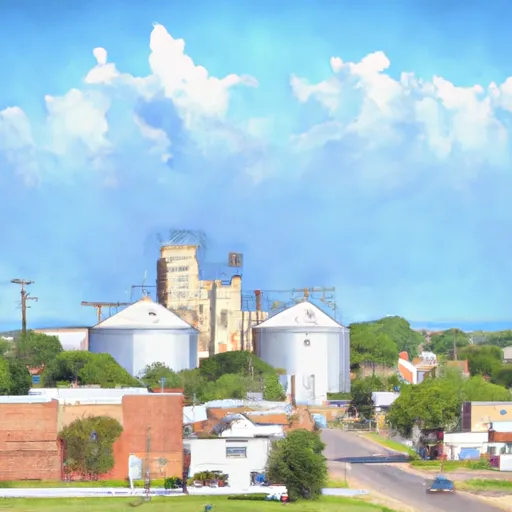-
 Snoflo Premium
Snoflo Premium
Get unlimited access to all our content
With no Ad interruptions! - Start Your Free Trial Login with existing account
Lafontaine
Eden Index
Climate
8.3
•
Recreation
3.1
•
Community
2.3
•
Safeguard
5.0/10

Lafontaine, located in Kansas, experiences a continental climate characterized by hot summers and cold winters. Summers are typically hot and humid, with temperatures ranging from the mid-80s to low 90s Fahrenheit. Winters are cold, with temperatures dropping below freezing, averaging in the mid-30s to low 40s Fahrenheit. Precipitation is relatively evenly distributed throughout the year, with an average of 40 inches annually.
The hydrology of Lafontaine includes several nearby lakes and rivers that provide recreational opportunities. The Neosho River flows through the region, offering fishing and boating opportunities. Additionally, nearby lakes such as Clinton Lake and Melvern Lake attract visitors for water-based activities like swimming, kayaking, and fishing. The area is also known for its prairie landscapes, offering opportunities for hiking, birdwatching, and wildlife viewing.
Lafontaine is a haven for outdoor enthusiasts, providing ample opportunities to explore nature. Whether it's enjoying water activities on the rivers and lakes or immersing in the beauty of the prairies, visitors can indulge in various outdoor recreational pursuits.
What is the Eden Index?
The Snoflo Eden Index serves as a comprehensive rating system for regions, evaluating their desirability through a holistic assessment of climate health, outdoor recreation opportunities, and natural disaster risk, acknowledging the profound impact of these factors on livability and well-being.
Climate Health Indicator (CHI): 8.3
Lafontaine receives approximately
1020mm of rain per year,
with humidity levels near 84%
and air temperatures averaging around
14°C.
Lafontaine has a plant hardyness factor of
6, meaning
plants and agriculture in this region thrive during a short period during spring and early summer. Most
plants will die off during the colder winter months.
By considering the ideal temperature range, reliable water supplies, clean air, and stable seasonal rain or snowpacks, the Climate Health Indicator (CHI) underscores the significance of a healthy climate as the foundation for quality living.
A healthy climate is paramount for ensuring a high quality of life and livability in a region, fostering both physical well-being and environmental harmony. This can be characterized by ideal temperatures, reliable access to water supplies, clean air, and consistent seasonal rain or snowpacks.
Weather Forecast
Streamflow Conditions
Verdigris
Area Rivers
Verdigris
Snowpack Depths
Verdigris
Reservoir Storage Capacity
Verdigris
Groundwater Levels
Recreational Opportunity Index (ROI): 3.1
The Recreational Opportunity Index (ROI) recognizes the value of outdoor recreational options, such as parks, hiking trails, camping sites, and fishing spots, while acknowledging that climate plays a pivotal role in ensuring the comfort and consistency of these experiences.
Access to outdoor recreational opportunities, encompassing activities such as parks, hiking, camping, and fishing, is crucial for overall well-being, and the climate plays a pivotal role in enabling and enhancing these experiences, ensuring that individuals can engage in nature-based activities comfortably and consistently.
Camping Areas
| Campground | Campsites | Reservations | Toilets | Showers | Elevation |
|---|---|---|---|---|---|
| Johnstone Park | 6 | 670 ft | |||
| Sun Dance - Melvern Lake | None | 1,079 ft | |||
| Outlet Park - Melvern | None | 979 ft | |||
| Coeur DAlene - Melvern Lake | None | 1,057 ft | |||
| Hickory Creek West - John Redmond Reservoir | None | 1,047 ft | |||
| Turkey Point - Melvern Lake | None | 1,075 ft | |||
| Arrow Rock - Melvern Reservoir | None | 1,087 ft | |||
| Hickory Creek East - John Redmond Reservoir | None | 1,050 ft | |||
| Gentry Creek Landing - Eufaula Lake | None | 607 ft | |||
| Eisenhower State Park | 230 | 1,082 ft |
Nearby Fishing
Catastrophe Safeguard Index (CSI):
The Catastrophe Safeguard Index (CSI) recognizes that natural disaster risk, encompassing floods, fires, hurricanes, and tornadoes, can drastically affect safety and the overall appeal of an area.
The level of natural disaster risk in a region significantly affects safety and the overall livability, with climate change amplifying these risks by potentially increasing the frequency and intensity of events like floods, fires, hurricanes, and tornadoes, thereby posing substantial challenges to community resilience and well-being.
Community Resilience Indicator (CRI): 2.3
The Community Resilience Indicator (CRI) recognizes that education, healthcare, and socioeconomics are crucial to the well-being of a region. The CRI acknowledges the profound impact of these elements on residents' overall quality of life. By evaluating educational resources, healthcare accessibility, and economic inclusivity, the index captures the essential aspects that contribute to a thriving community, fostering resident satisfaction, equity, and social cohesion.

